
TIPS ON CHOOSING A FRYING PAN
At Sitram, we offer a wide range of cookware to meet the cooking needs and preferences of all consumers.
Materials, coatings, shapes, sizes...there are several things to take into account when choosing a frying pan or skillet.
Which shape should you choose?
Everyone has at least one round frying pan. The most classic version, round frying pans can be used to cook the vast majority of foods.
But there are other shapes as well:
- Fish pans are oval;
- Blini pans have a smaller diameter;
- Grill pans are usually square or rectangular with a ridged bottom to recreate the experience of grilling;
- Crepe pans are wide and shallow and let you make delicious crepes all year long;
- Sauté pans are deeper and let you cook larger quantities and perform certain cooking techniques such as tossing food with a flip of the wrist. Sauté pans are the pans most often used by professionals and cooking enthusiasts;
- Woks are even deeper than sauté pans and ideal for preparing Asian recipes.

Which size?
Frying pans, or skillets, are go-to cookware for all your everyday meals. It is therefore important that you choose the right size. Your pan should allow you to cook for the number of people that usually sit around your table. Consider investing in a second, smaller frying pan to use with your larger pan when you have people over for dinner, or to reheat leftovers from the day before (for example).
The table below will help you choose the right diameter, but keep in mind that frying pan depths may vary:
| For 1 to 2 people | 20 cm diameter |
| For 2 to 3 people | 24/26 cm diameter |
| For 3 to 4 people | 26/28 cm diameter |
| For 4 to 5 people | 28/30 cm diameter |
| For 5 to 6 people | 30/32 cm diameter |
| For 6 to 8 people | 34/36 cm diameter |
- For a household of 2 adults or 2 adults and 1 child, you might choose a 20 cm and a 24 cm frying pan.
- For a household of 2 adults and 2 children, you might choose a 20 cm and a 28 cm frying pan.
- For a household of 4 adults or 2 adults and 3 children, you might choose a 20 cm, a 26 cm, and a 32 cm frying pan.
SITRAM offers clever products that help save space in your cupboards. Designed with a detachable handle, our Sitramovible and Sitramulti lines let you stack your frying pans inside each other.
Note: The choice of diameter not only depends on the number of people in your household, but also on the size of your cooktop.
Choosing the right diameter
Before choosing a frying pan diameter, it is important to measure the diameter of your cooktop:
- If your frying pan is too small for your cooktop, it can overheat and become damaged.
- If your frying pan is too big, then the pan takes longer to heat up and some parts of the pan are hotter than others.
Ideally, your kitchen should be equipped with several different-sized frying pans. This will enable you to maximize the performance of your cookware!

Is the frying pan compatible with your cooktop?
Not all frying pans or skillets are compatible with all types of cooktops. It depends on their primary material and their composition. Most SITRAM cookware is compatible with all types of hobs. However, be sure to check the symbols on the packaging before purchasing a product.
Oven-safe frying pans are versatile and easy to clean. They let you start a recipe on the stove and finish it in the oven. Our frying pans with detachable handles can be used in the oven without the handle. To determine whether the frying pan is oven-safe, check for the following symbols on the packaging of the product:
A frying pan for every purpose:
the pros and cons of each material
There's no such thing as a magic pan that can be used for all your recipes! Each material and coating has its pros and cons. Let's explore them below.
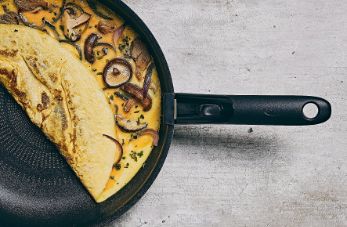
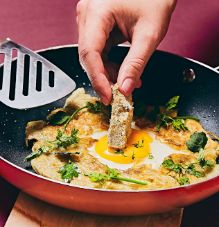
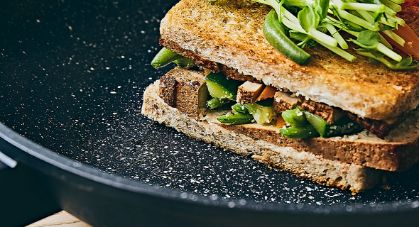
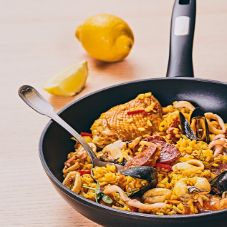
Most frying pans are made of aluminum. These pans offer many advantages when it comes to everyday cooking. They are always made with a coating as food should never come into direct contact with aluminum.
Our aluminum frying pans come with fixed or detachable handles. Detachable handles let you use the pans in the oven (always check the instructions on the packaging) and save space in your cupboards.
Use your aluminum pan for...
- Egg recipes: fried eggs, scrambled eggs, omelets, frittatas, and tortillas.
- Recipes made with little or no fat.
- Cooking over low heat.
Strong points
- Weight: Aluminum frying pans are lightweight and easy to clean and handle
- Conductivity: heat is distributed quickly and evenly
- Cooking: a non-stick coating lets you cook with little or no fat
- Use and care: the non-stick coating makes the cookware easier to clean
- Budget: in general, aluminum frying pans are the most affordable
Weak points
- Lifespan: even the most resistant coatings deteriorate over time. If this happens, you have to replace the pan.
- Compatibility: some aluminum frying pans (without reinforced bases) may not be compatible with induction cooktops.
- Cooking: these frying pans cannot be used over high heat as their coating can become damaged. This means they can only be used to make certain types of recipes.
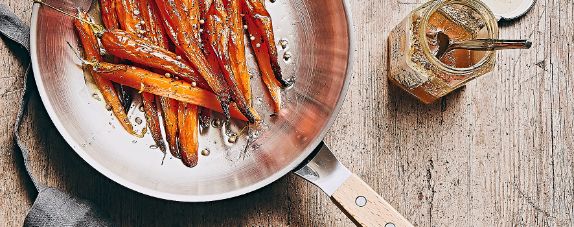
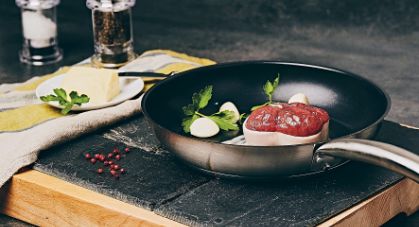
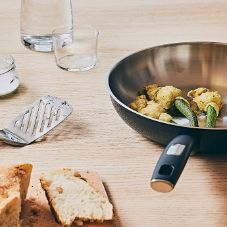
SITRAM is an expert in stainless steel. This material is extremely robust and resistant to heat, which also makes it a favorite amongst both amateur and professional cooks. Sitram has become an expert in stainless steel (in particular, premium 18/10 stainless steel) thanks to our vast experience producing stainless steel pressure cookers.
Stainless steel cookware can come with or without a coating. Coatings make stainless steel frying pans easier to use and clean. The handles of these pans are made of welded or riveted stainless steel or heat-resistant plastic. We also offer several stainless steel frying pans with detachable handles.
Use your stainless steel pan for...
UNCOATED STAINLESS STEEL FRYING PANS
- Seared meat, poultry, and vegetables: seared food deposits cooking juices on stainless steel surfaces, which then allows for caramelizing and deglazing.
- Cooking over high heat: there is no risk of damaging the pan.
COATED STAINLESS STEEL FRYING PANS
- Egg recipes: fried eggs, scrambled eggs, omelets, frittatas, and tortillas.
- Recipes made with little or no fat.
- Everyday cooking done over low or medium heat.
Strong points
- Robust: does not break or warp.
- Durable: as its name suggests, stainless steel does not rust (it is stainless).
- Use and care: stainless steel surfaces (inside and outside) are easy to clean after being soaked in water. You can even use abrasive sponges (except on coated stainless steel or other special cases indicated on the packaging).
UNCOATED STAINLESS STEEL FRYING PANS
- Durable: withstands high heat and vigorous cleaning. Uncoated stainless steel frying pans are virtually indestructible!
- Healthy: an inert material, stainless steel is perfectly healthy.
- Cooking: lets you sear meat, poultry, fish, and vegetables over high heat with no risk and obtain cooking juices by deglazing.
COATED STAINLESS STEEL FRYING PANS
- Cooking: a non-stick coating lets you cook with little or no fat.
- Use and care: the non-stick coating makes the cookware extremely easy to clean.
Weak points
UNCOATED STAINLESS STEEL FRYING PANS
- Cooking: fat (e.g., butter or oil) is required for certain foods.
COATED STAINLESS STEEL FRYING PANS
- Cooking: these frying pans cannot be used over high heat as their coating can become damaged. This means they can only be used to make certain types of recipes.
- Lifespan of coating: even premium coatings deteriorate over time (repeated use of metal utensils, abrasive sponges, etc.). When this happens, the frying pan must be replaced.
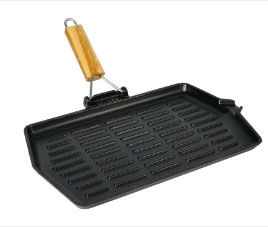
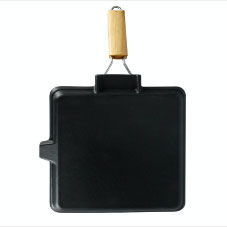
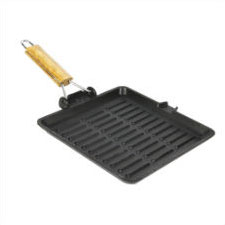
This material is mostly used by professionals. It offers a number of advantages, but also requires special care. At Sitram, we only use this material for certain types of cookware: grill pans (which are perfect for cast iron), and of course, our iconic cast iron Dutch ovens.
Use your cast iron pan for...
- Grilling meat, poultry, and vegetables: our grill pans are made with ridges that mark food like a BBQ grill.
Strong points
- Robust: natural cast iron is incredibly durable and can also withstand high temperatures and metal utensils.
- Cooking: cast iron distributes heat evenly and can be used over high heat.
Weak points
- The main weakness of cast iron is its heavy weight. A cast iron frying pan is 2 to 3 times heavier than an aluminum frying pan (hence the famous expression..."pumping iron!").
- Cast iron distributes heat evenly and retains heat for long periods of time; however, it takes longer to heat up than other materials.
- When cooking with cast iron cookware, you'll have to add a little fat (e.g., butter or oil). However, over time and with repeated use, cast iron frying pans develop their own natural, non-stick layer. When cleaning this material, we therefore recommend that you refrain from using detergents which can prevent this layer from forming.
By opting for several types of frying pans, you'll be able to make a multitude of recipes and master a variety of cooking techniques. You'll also be able to cook all kinds of food over both low and high heat. Meat, fish, eggs, delicate foods, foods cooked without fat...become the conductor of your kitchen, and make sure you have all the right instruments!
Use and care:
How do you extend the lifespan of
your frying pan?
Different materials and coatings require different care. However, there are certain precautions you can take for all your cookware.
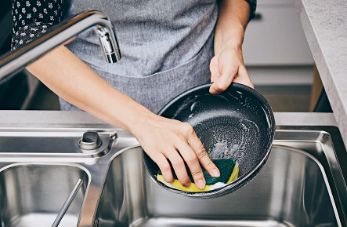
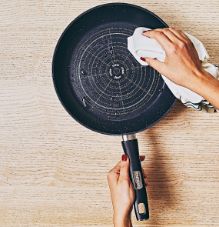
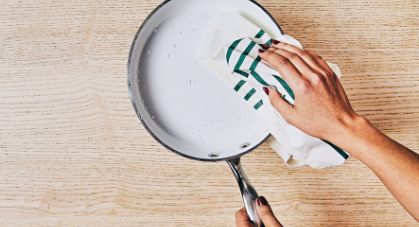
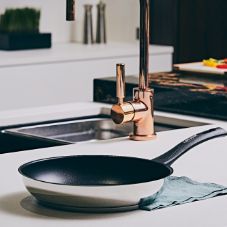
General precautions for your cookware
1. Never heat while empty: this can warp the body of the frying pan, severely damage its coating, and make the cookware unusable.
2. Never rinse hot frying pans with cold water: the difference in temperatures can also damage or warp the cookware. Wait at least 10 minutes before washing or soaking the pan.
3. Never use a knife to cut food directly in your frying pan, especially if the pan has a non-stick coating. As a rule of thumb, never use metal utensils with your cookware (stainless steel is an exception).
4. Most of our frying pans are dishwasher safe. However, keep in mind that dishwasher detergents are more aggressive than dishwashing liquids. Over time, they can cause deposits to form and even shorten the lifespan of your frying pan. We therefore recommend washing your cookware by hand whenever possible.
5. Avoid aggressive products such as oven or barbecue cleaners, and never use bleach. See our tips for removing stubborn stains.
6. Wipe your frying pan with a cloth before putting it away. This will prevent the formation of stains caused by water drops that are left to dry on their own.
See our Use and Care Guide for more information on caring for your frying pan.
You'll find our frying pans, skillets, sauté pans, crepe pans, and woks in most retail shops, as well as general or specialized stores on the Internet!
